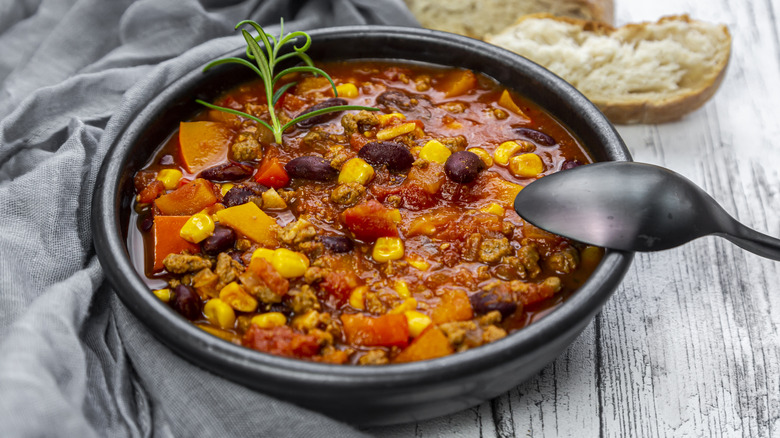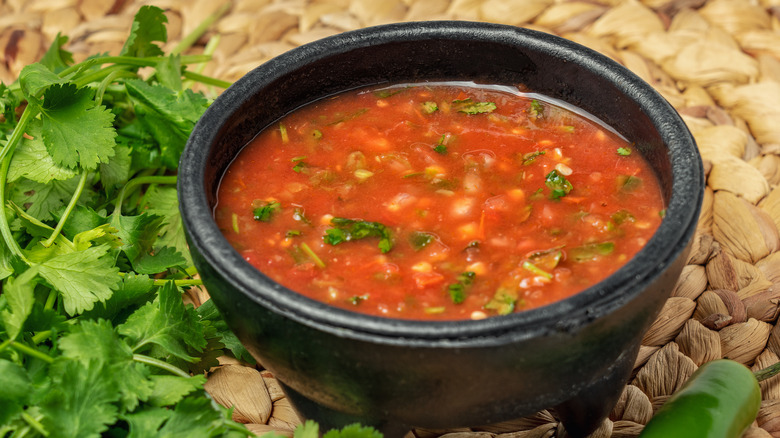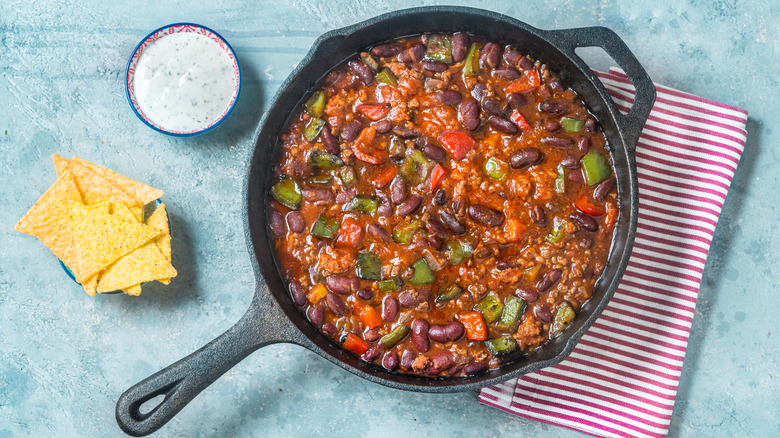The One Jarred Ingredient That Will Take Your Chili To A New Level
Chili is the very essence of homemade food — it's heartwarming, indulgent, and flavor-packed. It can even be made swiftly, thanks to quick and easy chili recipes. Ground meat, vegetables, and beans smothered in a bold sauce is a combination that never disappoints. It only gets better when salsa joins the mix. This Mexican staple brings excitement anywhere it goes, and with chili, the magic is as prevalent as ever.
This pairing, while not too common, isn't all that farfetched or mismatched. At both chili and salsa's core, you'll find tomato's distinctive tanginess. This lays the base for a seamless combination of flavors; even with all the savory, nutty, and herbaceous nuances in play, these dishes always harmonize. It makes sense, then, that they work well together. But salsa also comes with a vibrancy that uplifts chili's intricate depth. Simmered for a few hours, its smoky heat and subtle sweetness fold right in, creating unique flavor complexity that's sure to impress.
Many types of salsa to choose from
You're never short on options when it comes to choosing salsa for your chili. A classic homemade salsa can be whipped up in just 5 minutes using tomatoes, chili peppers, cilantro, lime, and robust spices. The spice level can be managed primarily by choosing a suitable type of pepper. Jalapeño is a familiar pick which ranges from mild to medium heat, while serrano and habanero pack quite a punch. For those who want just a touch of smokiness there's also salsa ranchera, a cooked version of regular salsa. The ingredients are pretty much the same but simmered together into a richer, deeper mixture. If you want to take things up a notch, salsa tequera is worth a try. This variety uses tomatoes, tomatillos, and chiles de árbol to create a vibrant blend of sweet, tangy, and spicy flavors.
Salsa verde, which uses roasted tomatillos instead of regular tomatoes, is an excellent match for white chili, possibly with shredded chicken. Bright and tangy with a smoky undertone, it does a marvelous job of complementing the dish's creaminess and adding extra dimension. This is an especially good choice for those who prefer something light on the palate yet still flavorful and infused with chili's quintessential warmth.
Adding salsa to your chili is a breeze
Once you've got the salsa, all that's left to do is add it to the pot of chili stewing on the stove. This can be done after you've sweat the aromatics and cooked the beef. Simply stir it straight into the tomato sauce and other ingredients until well combined. Let everything simmer for at least an hour or so, and your chili should be good to go.
Don't forget that you can always add other salsa-adjacent ingredients to diversify the dish even further. Other than onions, bell peppers, and corn, you can also throw in a few slices of fresh chili peppers to pack on the extra heat. Salsa seasoning such as ground cumin, smoked paprika, and chili powder aren't bad choices either. They blend in nicely with the salsa and build up the intensity without disrupting the flavor profile. For the topping, cheese and sour cream do the trick just fine, but with the dish's Mexican influence, a few avocado cubes can work as well.
When the chili hits the table, there's one last thing to complete it: the right side dish. We all have our go-to, whether it's crackers, cornbread, or plain white rice. Tortilla chips are another prime contender. Crunchy and playful, they strike a delightful textural contrast with the thick chili and make each bite more satisfying.


